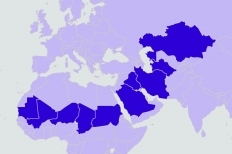EU Diplomacy Paper 3/2024
The Department of EU International Relations and Diplomacy Studies has published a new EU Diplomacy Paper entitled "The ‘Graveyard of Umpires’? The Hard-Learned Lessons that Afghanistan Taught EU...
 Throughout the academic year 2012-2013 the Department of EU International Relations and Diplomacy Studies at the College of Europe, Bruges campus, with the financial support of the European Commission, organised a series of events dedicated to the ‘neighbours of the neighbours’ of the European Union. This concept was introduced by the European Commission in the framework of the European Neighbourhood Policy (ENP) and refers mainly to countries in Saharan Africa, the Middle East and Central Asia.
Throughout the academic year 2012-2013 the Department of EU International Relations and Diplomacy Studies at the College of Europe, Bruges campus, with the financial support of the European Commission, organised a series of events dedicated to the ‘neighbours of the neighbours’ of the European Union. This concept was introduced by the European Commission in the framework of the European Neighbourhood Policy (ENP) and refers mainly to countries in Saharan Africa, the Middle East and Central Asia.
The concept of the ‘neighbours of the neighbours’ was introduced by the European Commission in 2006 in a Communication on strengthening the ENP, in which it stated that:
We should also look beyond the Union’s immediate neighbourhood, to work with “the neighbours of our neighbours”. In Central Asia, for example, or in the Gulf, the new instruments (…) will be able to fund regional cooperation activities including countries in both regions – this could be of particular importance in sectors such as energy, transport, environment and research policy. (…) Similar considerations also apply beyond the North African ENP countries, in the context of the EU-Africa Strategy, where broader regional cooperation programmes and cooperation in areas like migration, infrastructure, energy and peace and security will be of great interest. Looking beyond such regional cooperation activities, consideration might also be given to building a comparable agenda for dialogue and reform with Kazakhstan, in response to their expressed interest.
COM(2006)726, p. 11
After the Arab uprisings and the revision of the ENP, and a few months before the implementation of the new European Neighbourhood Instrument (ENI), it was very timely to take stock of the progress achieved so far and to see how this concept of the neighbours of the EU’s neighbours could be used to promote security, stability and prosperity beyond the EU’s immediate proximity. It seemed indeed necessary to launch an in-depth reflection on these issues as the world was witnessing the emergence of a new ‘arc of crisis’ beyond the EU’s immediate neighbourhood.
One of the key questions to be addressed in this framework was how the EU can create bridges between the different policy frameworks and models of co-operation and elaborate new comprehensive strategies aimed at stabilising and developing the Union’s broader neighbourhood by meeting the various challenges of the regions at hand.
Three regions have to be taken into consideration for the purpose of the analysis of the neighbours of the EU’s neighbours: